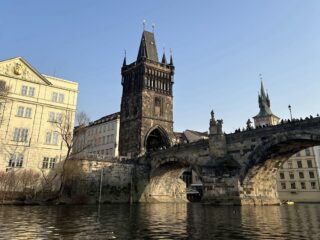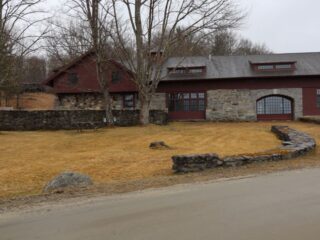by Ken Harbinson
As it happened, my wife was reading The Da Vinci Code as I was simultaneously absorbed in travel guides for our trip to the southwest of France. This is when the name ‘Sauniere’ emerged in both places. In the novel, he is the leader of a mysterious religious sect that for centuries has protected a ‘Holy Grail’–the secret that Jesus was married to Mary Magdalen and that their descendants may still be alive today. It is an enigma that threatens to vanquish centuries of Christian orthodoxy, and has been guarded for generations not only by Leonardo, but by a long list of historical luminaries.
When Sauniere is murdered in the Louvre of Paris by those seeking his Holy Grail, he leaves behind a baffling series of clues which take the book’s hero and heroine on a dangerous trail through the streets of Paris and into the lowlands of Scotland. Alas, The Da Vinci Code also filches the name of the real-life Abbe Berenger Sauniere together with the Holy Grail story surrounding this strange man. In yet another example of truth being stranger than fiction, the novel pales in comparison to the stories, speculations and fantasies surrounding this very real person.
Abbe Sauniere lived a century before the contemporary setting of the book–not in Paris, but in the remote hilltop village of Rennes-le-Chateau in southwest France. The story that he discovered proof of the marriage of Jesus to Mary Magdalen or perhaps even Mary’s tomb remains but one of the tales surrounding the Abbe. The village is just 26 miles south of the famously fortified (and quite touristy) city of Carcassonne. The scenic drive winded us through the verdant Aude River valley which is a green oasis between the dry and rocky landscapes lying to both to the east and west.
The road up to the village itself is a steep and coiling snake that ascends to the summit of what must be the highest hill in the region. Once at the top, a howling wind that often blows off the snow-capped Pyrenees only added to the eerie quality. Nothing, though, can diminish one of the most breathtaking panoramas we ever set our eyes upon. Directly below the springtime fields jumbled into a quilt pattern of lemon yellows and light greens. In the distance a blue haze engulfed rolling foothills. Finally, on the far horizon, the Pyrenees loomed over all.
Folklore in southern France has long maintained that after the crucifixion of Jesus some of his followers escaped to isolated Edens such as this. Thus, the great pilgrimage site at Rocamadour, a few miles north, is said to have held the remains of St Amadour who witnessed Jesus’ entry into Jeruselem before fleeing the Holy Land to become a hermit. Joseph of Arimathea, who owned the tomb in which Jesus was laid, is said to have passed this way. And, important to the Abbe Sauniere story, the appropriately named village of Saint-Maries-de-le-Mer still celebrates the presumed arrival of Mary Magdalen to its shores.
For the residents of Rennes-le-Chateau, all this obviously lends credence to the possibility that their village contains special secrets. It was the mystery and symbolism surrounding Berenger Sauniere, however, that has breathed life into the multitude of legends and speculations that swirl about this location. Sauniere arrived here as an impecunious village priest in 1885. Soon after, however, he had a seemingly endless supply of money which he spent lavishly on church buildings, village improvements, and extravagant entertainment for important people. Such spending endeared him to the villagers and made Sauniere a minor national celebrity in fin de siecle France. It also gave rise to stories about his returning from nocturnal trips loaded down with gold and about his finding ancient scrolls under the altar of the church. Then there was the story about the hidden door to a secret room behind the church sacristy and the enigmatic quote from his journal: “DISCOVERY OF A TOMB”. Finally, when he died in 1917, the priest who heard the Abbe’s last confession is said to have run out of the bedroom screaming with terror.
Such legends of bizarre happenings are more than confirmed in the buildings he left behind–most of all in his church that he named for Mary Magdalen. It contains enough obscure symbolism to supply grist for a dozen sequels to The Da Vinci Code. This begins at the main entry where we were greeted by a disconcerting engraving over the door saying: This is a terrible place. Stepping inside, a leering figure of a polychrome devil crouches just inside the door. Sauniere undoubtedly had something in mind with a nearby a polychrome figure of Jesus cowering in an identical way at the feet of John the Baptist, while a statue and a bas-relief of Mary Magdalen, constructed of human skulls, represent the beheaded John the Baptist.
Such oddities multiply in the frescos of the ‘Stations of the Cross’ that line the wall. There is a child dressed in tartans; the emblem of the House of Austria; and incongruous numbers on a pair of dice that some Sauniere mystery buffs have calculated in excruciating detail to be the key to hidden treasure. In France, all this has led to endless interpretations of what secrets the quirky Abbe Sauniere was conveying and more than a few expeditions of treasure hunters who thought they had the answer.
The one constant in Sauniere’s life was his endless fascination with Mary Magdalen. He traveled throughout southern France to visit places identified with her such as the ancient pilgrimage city Vezelay and the village of Saint-Maximin-la-Sainte-Baume. His buildings also celebrate her. The Villa Bethania that housed his many guests and where he hosted lavish parties was named for her home village in the Holy Land. His favorite retreat, was the Tour Magdalen that he built on Rennes-la-Chateau’s highest pinnacle to provide him an unsurpassed view of the valley below, and in the library where he spent countless hours. Tradition has it, that a secret passage and perhaps buried treasure lie beneath its foundation. Finally, we exited the Tour Magdalen, a short walk along the wind-blown Belvedere which leads to the all glass Tour en Verre, where once Sauniere, and now we, basked in a 360 degree view of his domain.
The Abbe’s unconventional lifestyle and his unwillingness to explain, let alone share, his mysterious wealth finally became more than Sauniere’s bishop could abide–he was stripped the rights to say mass in the church he had built. Unrepentant, he set up a chapel in his Villa Bethania where crowds of villagers attended, leaving the pews of the Magdalen church virtually empty except for the few perplexed visitors who might come to ponder what the phrase “This is a terrible place” over the front door might mean.
The Presbytery, now a museum, was where Sauniere lived along with his faithful and highly superstitious young servant named Marie Denarnaud. It displays not only the remarkable story of Sauniere but also the long history of Rennes going back to Roman and medieval times when it was a ‘Royal City.’ We wandered through the museum for the better part of two hours absorbing just some of these stories.
Berenger Sauniere died in 1917, but the story does not end here. Marie, his servant, lived on until 1953 (dying on the same date that Sauniere was striken) while perpetuating the mystery by giving out tantalizing hints of treasure and world-shaking secrets. She made statements like “People are walking on gold without knowing it.” Or, “With what the priest left, we could feed all of Rennes for a hundred years and there would still be some left over.” Suggestions such as these brought out hordes of treasure hunters to dig up the surrounding countryside until, in 1965, the French government finally passed a law forbidding it. Now, it is reported, the treasure seekers are, at least, more discreet.
Besides giving hints of untold riches, Marie promised her close friend, a certain Monsieur Noel Corbu, that she would confide in him a momentous secret that would make him not only “rich” but “powerful.” Sauniere experts, of course, are certain that this can only be the final secret of the “Holy Grail.” Alas, however, before the secret could be conveyed and the mystery solved, Marie suffered a massive and disabling stroke that left Monsieur Corbu just as frustrated and empty-handed as was the hero of The Da Vinci Code.








